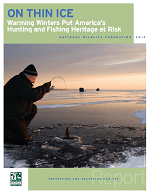We have much more to do and your continued support is needed now more than ever.
The Snowshoe Hare, Fashion Victim of Climate Change
Spring came to DC early this year with temperatures reaching into the low 80s by mid-March. While most people were thrilled about the unseasonably warm weather, I found myself unprepared. Having only moved to DC recently, my shorts and sandals are still packed away in Richmond, leaving me wearing winter clothes in a city already swarming with floral sundresses. After reading the recent NWF report On Thin Ice: Warming Winters Put America’s Hunting and Fishing Heritage at Risk, I realized I wasn’t the only who’s been dressing for the wrong weather lately – the snowshoe hare was stuck sporting a white coat in a winter that saw very little snow.
 Species that depend on camouflage to blend in with snow in the winter face unique threats from climate change. With less snow for protection, they become more susceptible to hungry predators. Species like the snowshoe hare are struggling to adapt effectively to warmer temperature and reduced snow fall, and this seriously threatens their chances for survival.
Species that depend on camouflage to blend in with snow in the winter face unique threats from climate change. With less snow for protection, they become more susceptible to hungry predators. Species like the snowshoe hare are struggling to adapt effectively to warmer temperature and reduced snow fall, and this seriously threatens their chances for survival.
Nowhere to Hide
During warm months, the snowshoe hare’s coat is a rusty brown, but when the days start to shorten, the hare’s coat whitens to hide it from predators like lynxes, coyotes, and eagles. Unfortunately, in recent years, snow is falling later and melting sooner, leaving the snow-white rabbit dangerously conspicuous against a green and brown background. According to the NWF report:
“…Winter is becoming less white: The extent of snow cover across the Northern Hemisphere has decreased by approximately 3 to 9 percent since 1978, with especially rapid declines in the western United States. Climatologists expect these trends to continue, and they project that by the end of the century, parts of the Northeast will lose as many as half of their snow-covered days each year.”
This is a particularly deadly forecast for the snowshoe hare who may not be able to adapt quickly enough to survive these changes. While it’s only natural for these rabbits to provide sustenance to hungry predators throughout the winter, if the hares become too easy to catch, entire hare populations could be at risk, along with the species that rely on them for food. According to University of Montana researcher Scott Mills, “Hares are important because they are prey for almost everything in the forest that eats meat. Without hares, the ecosystem unravels.”
Getting Back on Trend
For the snowshoe hare, wearing white after Labor Day is more than just a faux pas – it’s a matter of life and death. Fortunately, the Environmental Protection Agency has begun the process of tackling climate change by proposing historic limits to industrial carbon pollution from new power plants. Big polluters are expected to challenge these limits, so it’s up to us to show our decision-makers that we want the EPA to protect wildlife from the dirty fossil fuels that cause climate change. The future of snowshoe hares depends on it.
Protect the future of snowshoe hares, polar bears, and other wildlife imperiled by global warming by urging the EPA to finalize a strong standards to reduce carbon pollution from power plant smokestacks.
Read the full report On Thin Ice: Warming Winters Put America’s Hunting and Fishing Heritage at Risk at NWF.org/CleanAir






















